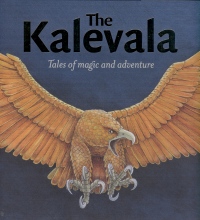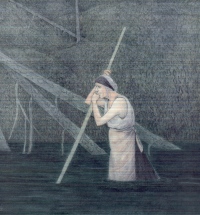| ________________
CM . . . . Volume XVI Number 5. . . .October 2, 2009. 
 |
The Kalevala: Tales of Magic and Adventure.
Kirsti Mäkinen, adapter. Illustrated by Pirkko-Liisa Surojegin. Translated by Kaarina Brooks.Vancouver, BC: Simply Read Books, 2009.
214 pp., hardcover, $29.95.
ISBN 978-1-897476-00-0.
Grades 8 and up / Ages 13 and up.
Review by Gail de Vos.
***/4
|
| |
|

excerpt:
The idea of Sampo began to fascinate him. A wonderful object that did not yet exist in the world. Whoever possessed Sampo would have eternal happiness, wealth, and power, and would get whatever the owner wished for.
Ilmarinen set to work.
But in Pohjola there was no smithy, no forge, no bellows. Besides, the materials needed for making Sampo were almost without substance——the tip of a swan’s quill, a drop of milk from a barren cow, one grain of barley, on curl of lamb’s wool...
But Ilmarinen did not give up. For days on end he searched, and at last he found a striped stone for the base of the forge. Then he assembled a forge and bellows.
Ilmarinen lit a fire, stuffed the materials for Sampo into the furnace, and made slaves blow the bellows. Slowly, from amid the flames, the dim outline of an object began to take shape.
What was emerging from the flames? Ilmarinen bent down to look.
This recent translation of the national epic poem of Finland is filled with colour, drama and excitement both in the illustrations and prose. While the episodic chapters and narrative may seem a bit stilted, it amply conveys the powerful mythological and mystical stories that have captivated not only the Finnish imagination but those far flung from this epic landscape.
 While the original epic consists of 22,795 verses, divided into 50 chapters, Mäkinen’s Finnish prose, translated by Canadian Kaarina Brooks, is divided into 20 chapters interspersed with illustrations and translated runes from the epic itself. The first seven chapters include the story told in the first ten chapters of the original piece telling of the origin of Earth and introducing the characters Vääinäämööinen and Joukahainen, their relationship with each other and the influence that this relationship has on the rest of the story. This story cycle ends with the main character of the Kalevala, Vääinäämööinen, tricking the blacksmith Ilmarinen to forge Sampo so he can acquire the Mistress of the North for his wife. The following chapters tell the complicated nine cycles of stories of the main characters and their attempt to forge out their own futures.
There is a great deal of violence, but this is handled well in the translation and is not apparent in either the evocative but restrained black-and-white or coloured illustrations. While marketed by the publisher for children as well as older readers, this reviewer feels that the intended readers should be more mature as to more fully appreciate the understated delivery that this book as object presents. A prologue introduces the reader to the historical and literary significance of the national epic, and the four-page glossary offers both a pronunciation guide and an aid to clarify and remind the readers of the largely unfamiliar Finnish mythological characters and geography. While the original epic consists of 22,795 verses, divided into 50 chapters, Mäkinen’s Finnish prose, translated by Canadian Kaarina Brooks, is divided into 20 chapters interspersed with illustrations and translated runes from the epic itself. The first seven chapters include the story told in the first ten chapters of the original piece telling of the origin of Earth and introducing the characters Vääinäämööinen and Joukahainen, their relationship with each other and the influence that this relationship has on the rest of the story. This story cycle ends with the main character of the Kalevala, Vääinäämööinen, tricking the blacksmith Ilmarinen to forge Sampo so he can acquire the Mistress of the North for his wife. The following chapters tell the complicated nine cycles of stories of the main characters and their attempt to forge out their own futures.
There is a great deal of violence, but this is handled well in the translation and is not apparent in either the evocative but restrained black-and-white or coloured illustrations. While marketed by the publisher for children as well as older readers, this reviewer feels that the intended readers should be more mature as to more fully appreciate the understated delivery that this book as object presents. A prologue introduces the reader to the historical and literary significance of the national epic, and the four-page glossary offers both a pronunciation guide and an aid to clarify and remind the readers of the largely unfamiliar Finnish mythological characters and geography.
Recommended.
Gail de Vos teaches at the School of Library and Information Studies for the University of Alberta and is the author of eight books on storytelling and folklore.

To comment on this title or this review, send mail to
cm@umanitoba.ca.
Copyright © the Manitoba Library Association. Reproduction for personal use is permitted only if this copyright notice is maintained. Any other reproduction is prohibited without permission.
NEXT REVIEW |
TABLE OF CONTENTS FOR THIS ISSUE- October 2, 2009.
AUTHORS |
TITLES |
MEDIA REVIEWS |
PROFILES |
BACK ISSUES |
SEARCH |
CMARCHIVE |
HOME |

 While the original epic consists of 22,795 verses, divided into 50 chapters, Mäkinen’s Finnish prose, translated by Canadian Kaarina Brooks, is divided into 20 chapters interspersed with illustrations and translated runes from the epic itself. The first seven chapters include the story told in the first ten chapters of the original piece telling of the origin of Earth and introducing the characters Vääinäämööinen and Joukahainen, their relationship with each other and the influence that this relationship has on the rest of the story. This story cycle ends with the main character of the Kalevala, Vääinäämööinen, tricking the blacksmith Ilmarinen to forge Sampo so he can acquire the Mistress of the North for his wife. The following chapters tell the complicated nine cycles of stories of the main characters and their attempt to forge out their own futures.
There is a great deal of violence, but this is handled well in the translation and is not apparent in either the evocative but restrained black-and-white or coloured illustrations. While marketed by the publisher for children as well as older readers, this reviewer feels that the intended readers should be more mature as to more fully appreciate the understated delivery that this book as object presents. A prologue introduces the reader to the historical and literary significance of the national epic, and the four-page glossary offers both a pronunciation guide and an aid to clarify and remind the readers of the largely unfamiliar Finnish mythological characters and geography.
While the original epic consists of 22,795 verses, divided into 50 chapters, Mäkinen’s Finnish prose, translated by Canadian Kaarina Brooks, is divided into 20 chapters interspersed with illustrations and translated runes from the epic itself. The first seven chapters include the story told in the first ten chapters of the original piece telling of the origin of Earth and introducing the characters Vääinäämööinen and Joukahainen, their relationship with each other and the influence that this relationship has on the rest of the story. This story cycle ends with the main character of the Kalevala, Vääinäämööinen, tricking the blacksmith Ilmarinen to forge Sampo so he can acquire the Mistress of the North for his wife. The following chapters tell the complicated nine cycles of stories of the main characters and their attempt to forge out their own futures.
There is a great deal of violence, but this is handled well in the translation and is not apparent in either the evocative but restrained black-and-white or coloured illustrations. While marketed by the publisher for children as well as older readers, this reviewer feels that the intended readers should be more mature as to more fully appreciate the understated delivery that this book as object presents. A prologue introduces the reader to the historical and literary significance of the national epic, and the four-page glossary offers both a pronunciation guide and an aid to clarify and remind the readers of the largely unfamiliar Finnish mythological characters and geography.